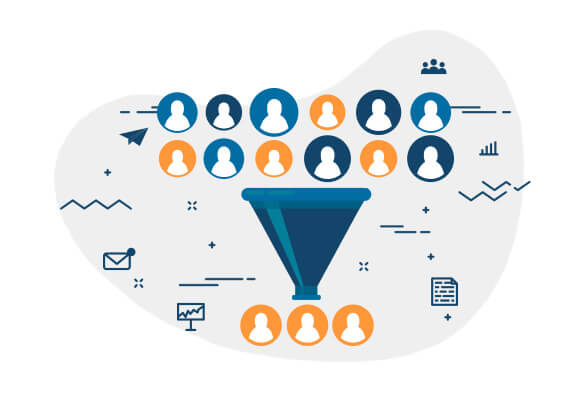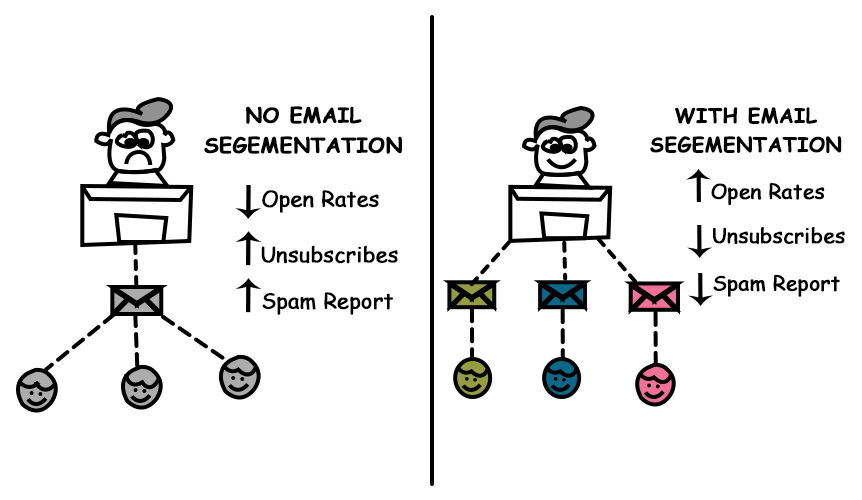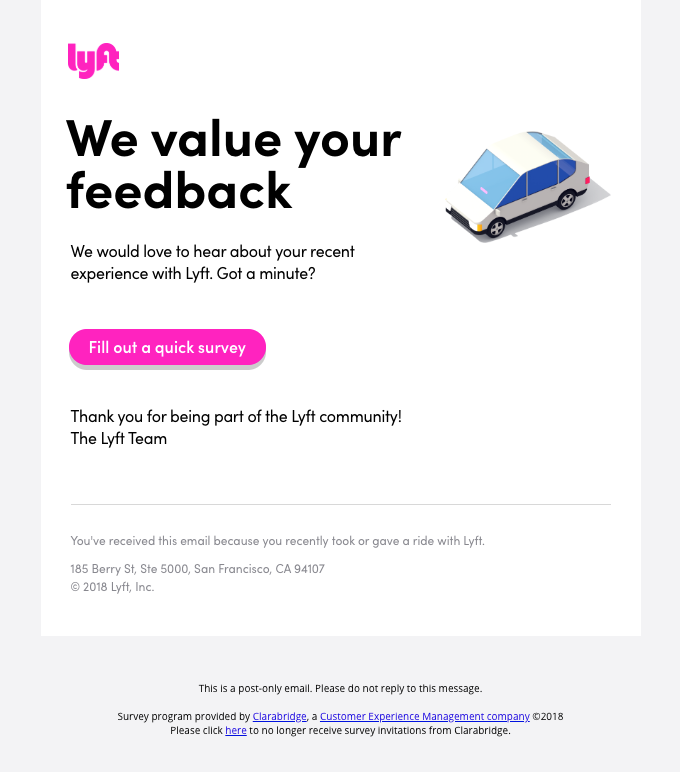Opening now...
12 email segmentation strategies to start using now
Most likely, you are a part of some businesses’ email segments and have received a targeted, personalized email from them. Maybe you even used that content to your advantage — clicked through to see new products on the website, took a survey or completed a purchase.
These and other conversions are the results of email segmentation. But what are some best practices and how can you segment your own subscriber list?
<div class="anchor-wrapper"><div id="email-segmentation" class="anchor-target"></div></div>
What is email segmentation?
Email segmentation is when you break up a list of email subscribers into smaller groups based on certain criteria. The datasets you use to segment your subscribers can represent different things, from newly subscribed people to customers that live in a specific town.

The main reason why email segmentation is such a useful practice is that it allows you to personalize your emails to a great extent. This means you can target subscribers with the type of emails, products, and offers they want to receive, which leads to higher engagement and retention.
Here are some key statistics proving how crucial content personalization through email segmentation is to a business’ marketing strategy:
- 67% of subscribers expect emails to be tailored to their characteristics, interests, needs, wants and painpoints.
- 42% of subscribers find non-personalized, generic emails to be frustrating.
- 20% increase in sales has been reported as the result of personalized email campaigns.
You can experiment with segments as much as you need to find the perfect content for each target recipient group. Naturally, the narrower your segment is, the more personalized the content is and the more likely it is to appeal to your subscribers.
As you change up your segments, don’t forget to run a regular email list clean-up. This will make sure that you send content to those who want it and avoid spamming other recipients.
<div class="anchor-wrapper"><div id="benefits-of-email-segmentation" class="anchor-target"></div></div>
Benefits of email segmentation

Email is a powerful tool for personalized communication — you can direct the right messages to smaller parts of your audience instead of sending the same general content to everyone. This, in turn, provides plenty of benefits:
- Higher open rates: as you can imagine, emails that appeal to the reader on a personal level get more clickthroughs than those they find useless and irrelevant.
- Lower unsubscribe rates: there are fewer reasons for a reader to unsubscribe if they receive emails that are tailored to their interests and preferences.
- Growing conversion rates: relevant content includes products and offers that are specifically chosen for each segment, so you get more clicks and traffic.
- More engagement: as the recipient reads a targeted email, they are more likely to interact with the content, like CTA buttons.
- Improved email deliverability: just like users are less likely to unsubscribe, they don’t usually flag relevant content as spam, which prevents your email address from being blacklisted.
As you can see, email segmentation helps boost the success of your marketing efforts, which can lead to an increase in sales and the growth of your business.
<div class="anchor-wrapper"><div id="email-segmentation-ideas" class="anchor-target"></div></div>
12 email segmentation ideas
There are so many ways to approach email segmentation for your targeted email marketing. Here are 12 ideas for email segments that you can use in your next email campaign.
1. Demographics
Demographic data is valuable information you can collect from your audience to use for email segmentation. This includes gender, age, location, income level, company position, and other data.
For example, people’s gender is important if you’re a clothing retailer. Or, their location would be good to know if you run a restaurant.
This is useful information to collect during sign-up of from previous purchases. Choose several demographics that will help you segment based on your product or service and stick to those. Be careful not to ask too many questions, though, because this can cause too much friction in the sign-up process and cause users to abandon your product before they even get started.
2. Survey/Quiz results
If you don’t collect much data during sign-up or want to get more details on your audience’s tastes and preferences, surveys and quizzes are the way to go.
You can be creative with a survey or a quiz and craft it according to your business needs and product. Keep in mind that you’ll probably have to add some motivation for the subscribers to want to take it.
For example, you can make a fun quiz that they will want to take to learn their results. Or, turn a survey into an opportunity to win a discount code.

And based on the results, you now have access to valuable data for email segmentation and can use their tastes, beliefs, interests and views to craft personalized emails.
3. Customer personas
A detailed overview of your customers, including a deeper dive into their values, wishes and pains, makes up a customer persona. These, in turn, allow you to personalize your content to a great extent.
By identifying personas among your customers, you can segment out pet owners, parents, Android users, Disney lovers, etc., and use these details to create tailored content that will most likely convert.
Surveys are the easiest way to create segments of customer personas within your audience. You can also track data on what devices your consumers use, their location if enabled and other details.
4. Email engagement
Email engagement metrics include open rates and interaction with email content, which you can use to segment subscribers into active and non-active or interested and not interested. You can track these metrics using email tracking and email marketing software.
This kind of segmentation allows you to create campaigns to re-engage users. By sending inactive subscribers content that may capture their attention, like introducing your new products or offering a special deal, you can boost their interest in your brand and turn the customers back into active ones.
Or, target those who show their interest in an event, like a sale, with special offers. So, if you notice some of your subscribers interacting with your sale announcement email, send them some product recommendations, for example, to encourage them to buy more items.
5. High open rates
Following the logic of the previous email segmentation practice, you can segment your audience by their email open rates. Those who open half of your emails or more are clearly interested in what you send them. So you can make the most use of this opportunity and treat them like your loyal customers — offer special deals and exclusive content.

Or, you can go further and narrow down your segments by what kind of emails they open the most. Do they prefer promotional content, brand updates or new product introductions?
You can also experiment by sending new types of content, tracking their response, and comparing it to their typical open rates.
6. One-time vs. Frequent customers
Tracking frequent buyers and loyal customers allows you to segment them from one-time customers and gives you opportunities to target both with special offers.
For customers who purchased from you once but never came back, offer individual promo codes to encourage them to buy again. Or, send more information about your brand to build their trust and make it familiar to them.
As for those customers who buy from you regularly, you need to keep their interest in your products by upselling and promoting new products or features. Celebrating their anniversaries with your brand is also a great practice, as well as offering exclusive deals and launching a loyalty reward program.
7. Past purchases
Past purchases give you a lot of information for your next targeted campaigns, which makes purchase history valuable data for segmentation. Of course, depending on the products purchased, your next campaign will look different.
For example, you can focus on products that might need refilling, like cosmetics. By calculating when the customer may run out of it, you can send an email reminding them to refill.
Another way you can use past purchases for email marketing is by recommending complementary products, like accessories, or similar products to the customer. This way, you can encourage them to make a purchase while also introducing your other products.
8. Amount spent
If you’re an online retailer and have products ranging in price significantly, segmenting customers by how much they spend can be an effective strategy. You can make as many or as few segments as you find useful and then target them with different offers accordingly.
For instance, you can find that there are VIP customers who afford your pricier products. Others would be customers motivated by sales, meaning that they usually shop in that “Reduced price” section of your website.

With this in mind, there’s no point in offering discounts to VIP shoppers as they already agree to buy expensive items. Instead, you can offer them exclusive products, events or other limited items. At the same time, smaller but more frequent deals will encourage the other segment to buy more.
9. Position in the sales funnel
The customer’s position in the sales funnel can tell a lot about what kind of email they want to receive and gives you an excellent opportunity to personalize the message.
When someone has just signed up and is at the top of the funnel, they need more general content to get familiar with the brand and your range of products. Welcome and onboarding emails are perfect for subscribers at this position in the funnel.
Naturally, the content of your emails will have to change as the customer moves through the funnel so you can nurture those leads. The closer they are to the bottom of the funnel, the more narrowed down your suggestions should be since now you know what products the customer is interested in.
Cart abandonment emails are an example of emails that users at the bottom of the sales funnel should receive. At this point, they need a reminder email as a little push to complete their purchase.
10. Website behavior
Using tools to keep an eye on your customer’s website behavior can also give you a lot of data for email segmentation. In particular, you can use the following information:
- pages visited
- pages not visited
- related pages missed
- icons clicked
- products viewed
- videos watched
Use these and other metrics to customize your email campaigns. You can send out similar products to those that subscribers viewed, reminders of the products from pages where they stayed longer to revive their interest or send content suggestions they may like to get them back to the website.
11. Restock pursuers
Sometimes people leave your website without a purchase, and the reason for that can be that the item they wanted is out of stock. That’s what the "Email me when back in stock" feature is for. By clicking on that button, a person is automatically added to the segment.
Now you have a segment you can target when you refill your stock, for updates or with other offers.

12. Changes in behaviors
Life gets busy, and it can happen that your customers stop placing orders for several months. Or vice versa, a rarely active buyer has started purchasing. Take your chance and react to these changes with emails.
If you notice that a regular customer has stopped buying, give them a little push to get back to shopping, like a discount code. Or, send them a survey to find out what made them stop buying from you. Maybe it’s something unrelated to you, but maybe it is — then you can fix it to prevent other customers from dropping off.
<div class="anchor-wrapper"><div id="track-email-segmentation-success" class="anchor-target"></div></div>
How to track email segmentation success
To know whether your email segmentation is working, track how your email marketing campaigns are doing. You can use your email marketing and tracking tools to see reports on various metrics. Here are the metrics that matter most:
- clickthrough rate
- conversion rate
- emails open
- emails bounced
- people unsubscribed
- list growth
Besides, overall ROI is another key metric to keep track of — you want to know whether your campaigns are paying off.
Segment emails for personalized content and higher conversion
Email segmentation is a powerful asset in the marketing strategy of any e-commerce business. By dividing email subscribers into segments, you can create personalized content that appeals to them. This gives you higher conversions, engagement and email deliverability.
Subscribe to our blog
Stay in the loop with Streak’s latest features and insights.
Related articles
No items found.



.webp)


